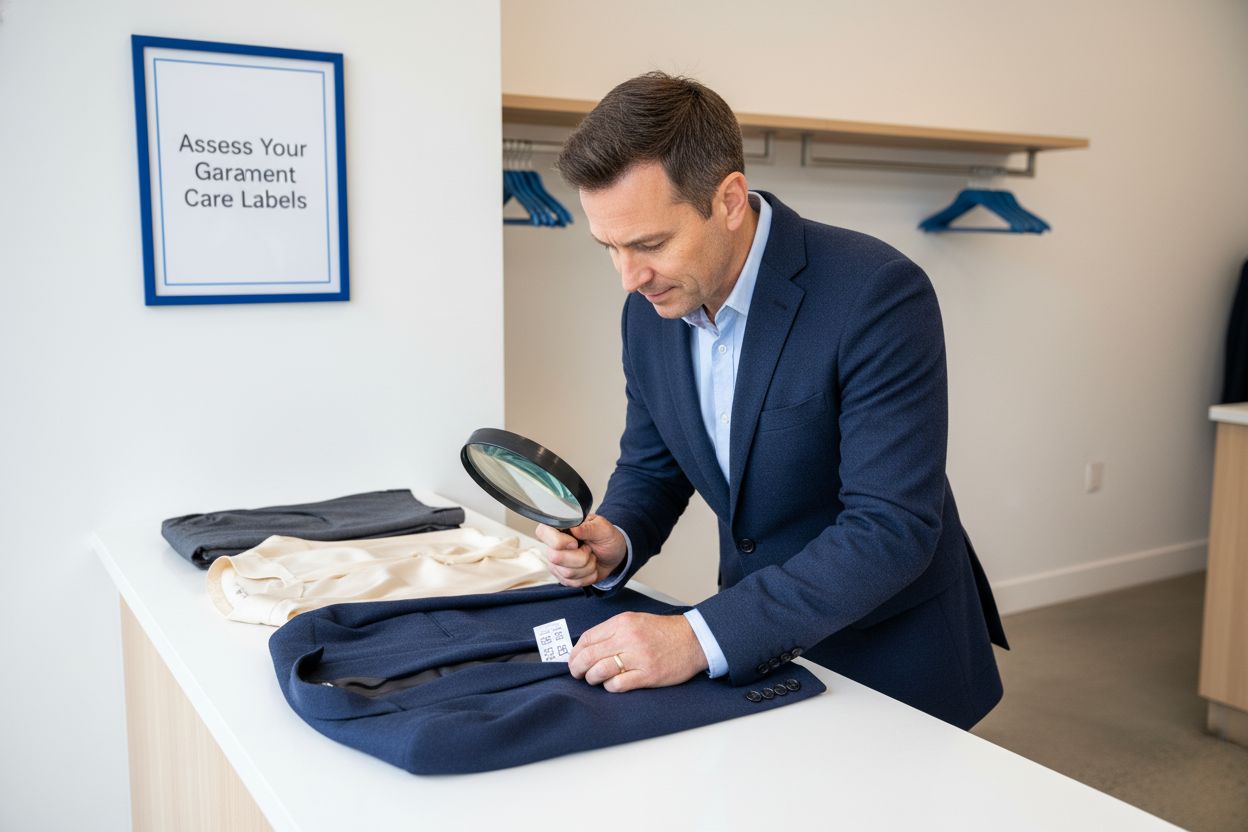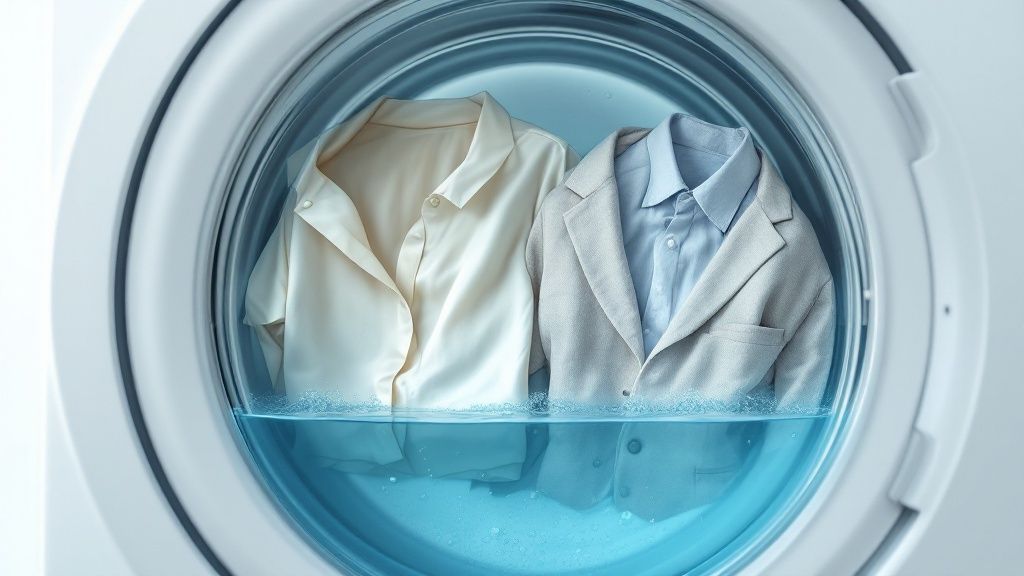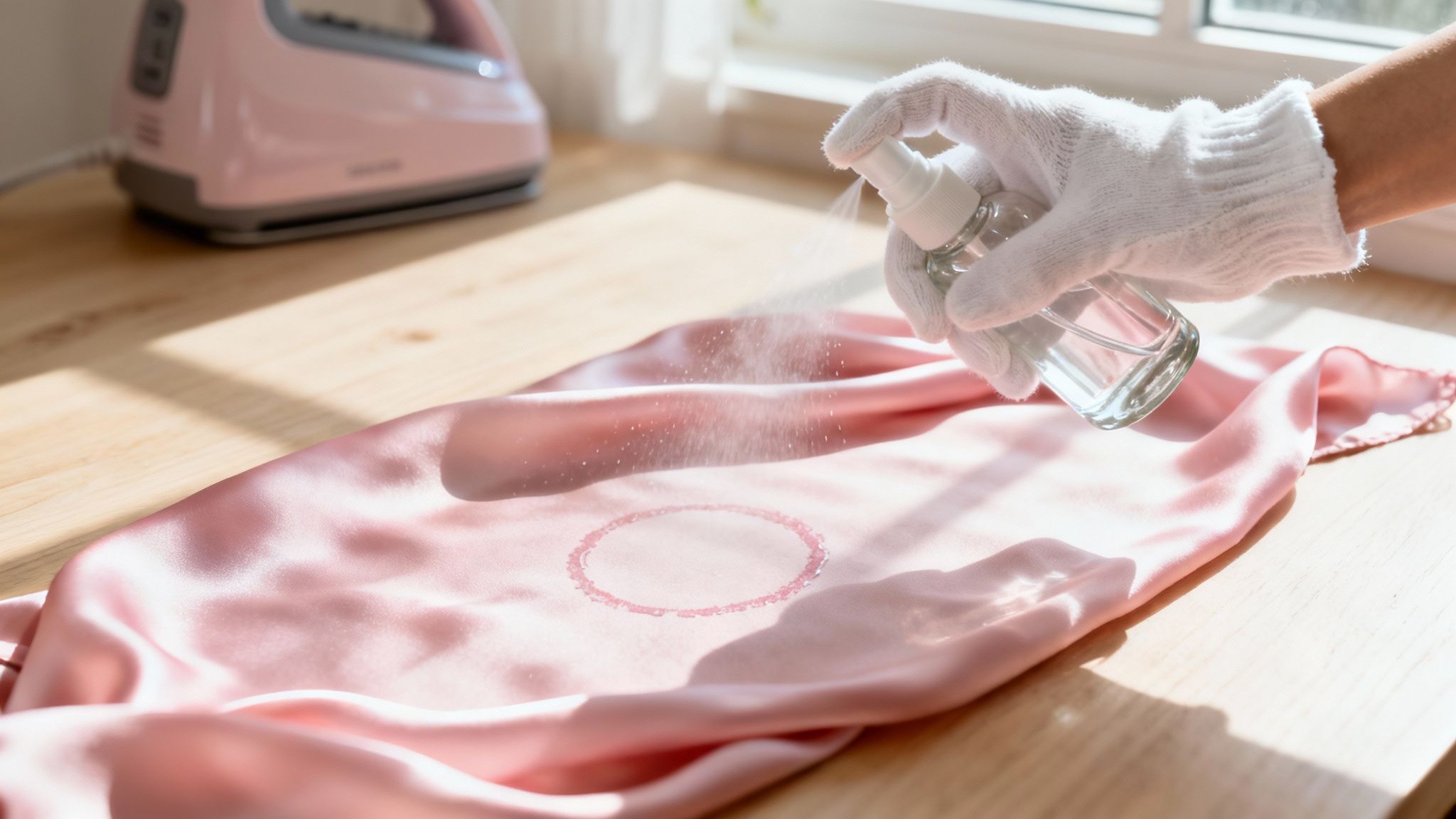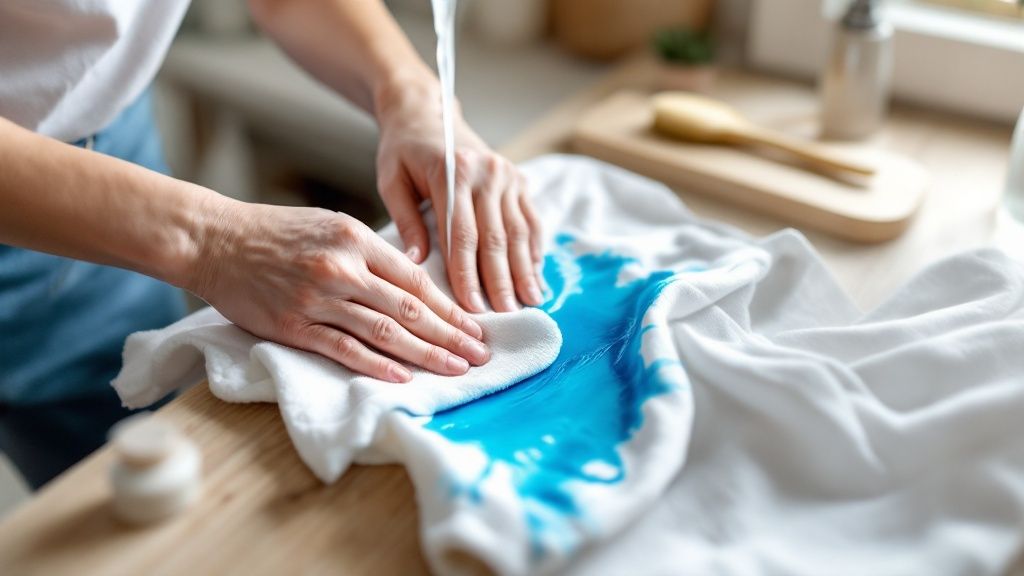How to Remove Oil Stains From Any Fabric
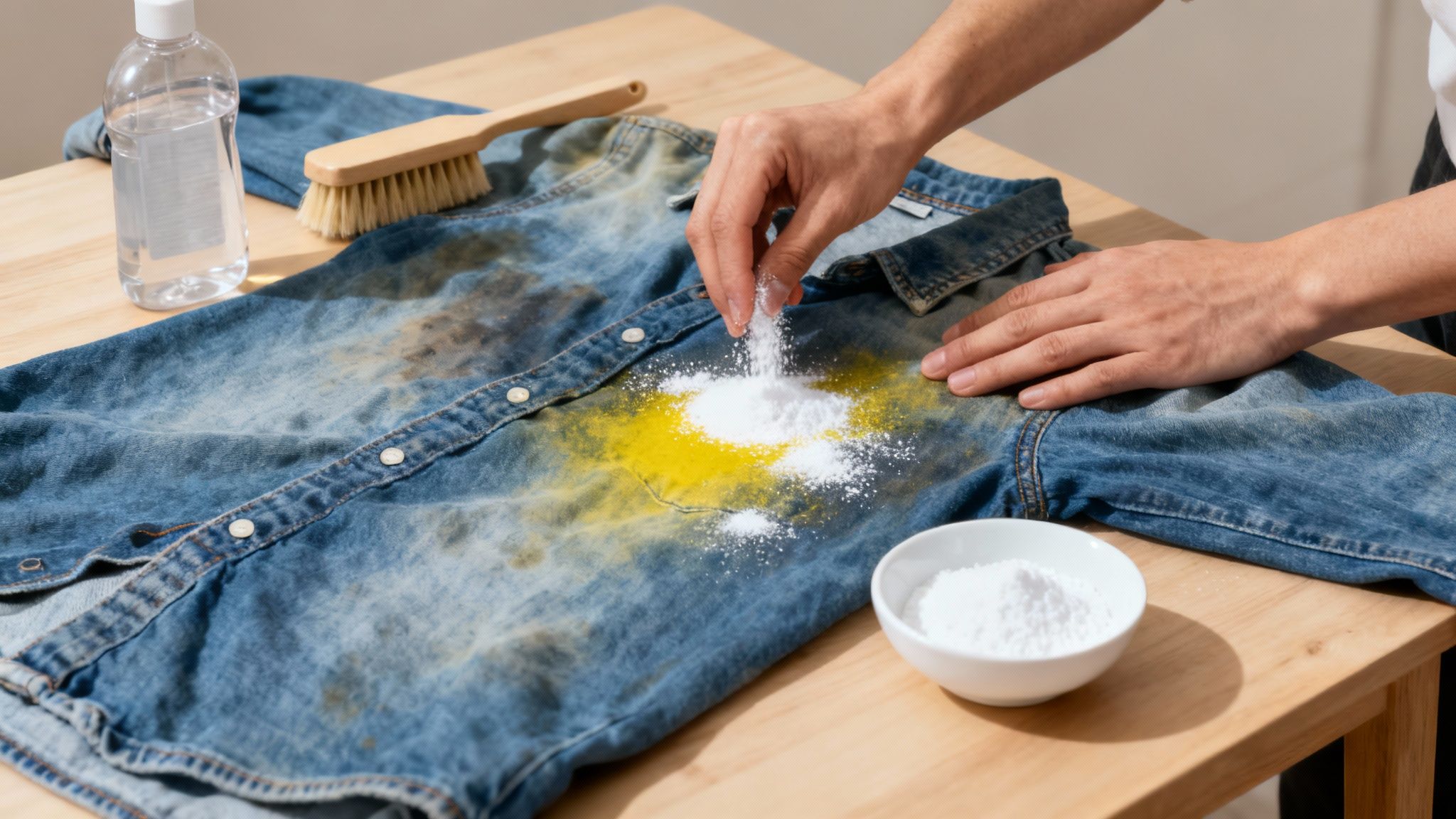
That sinking feeling when a rogue drop of salad dressing lands on your shirt or hot oil splatters from the pan is all too familiar. It feels like a race against time, but the good news is you can absolutely win. The secret to tackling fresh oil stains is all about acting fast—blotting the excess and using an absorbent powder like cornstarch to pull the grease out before it has a chance to set.
This simple, immediate response is your best defense against a permanent mark.
Your First Move Against a Fresh Oil Stain
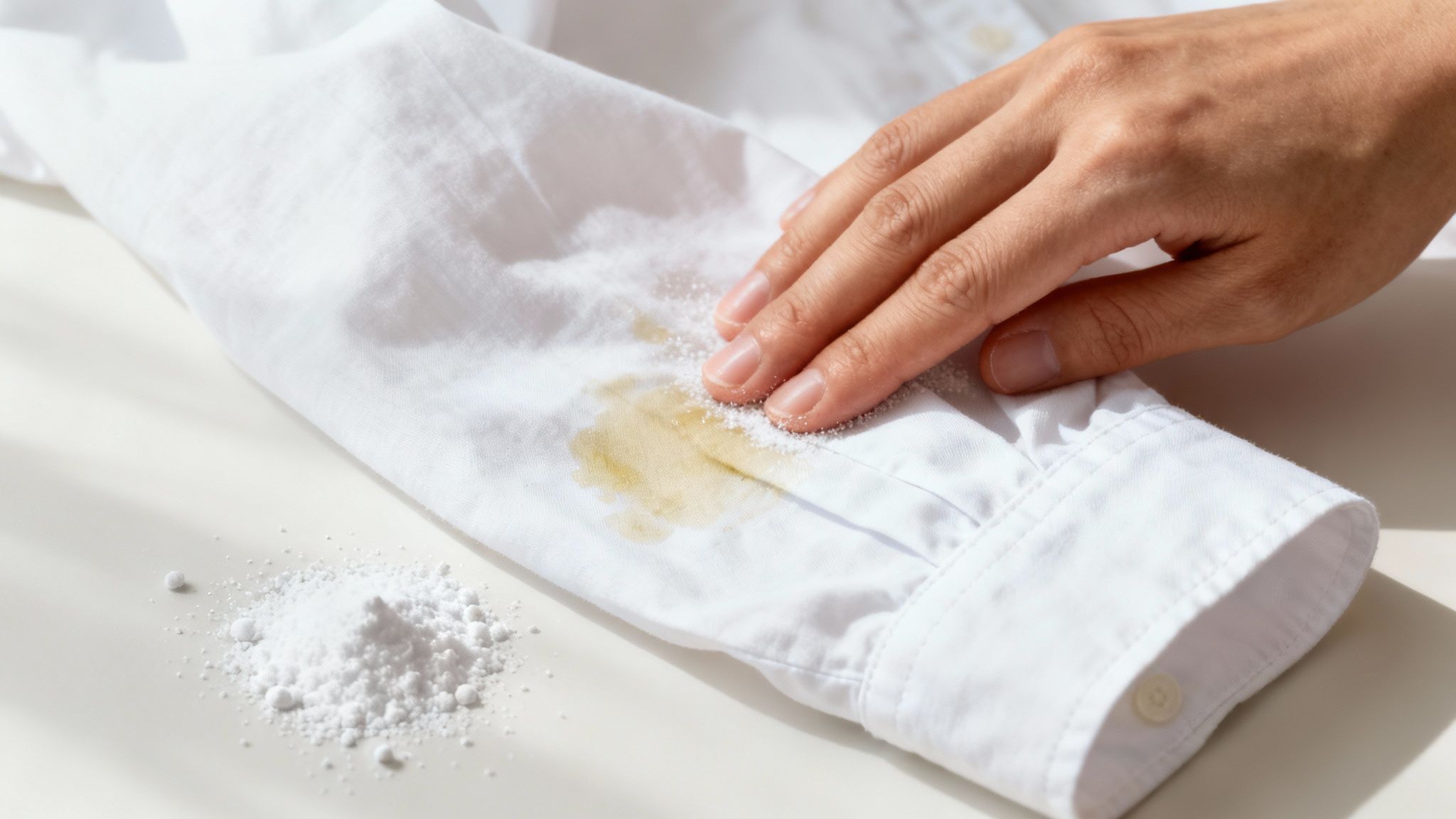
The first few minutes after an oil spill are the most critical. Your only goal should be removing as much of that liquid grease as you can before it works its way deep into the fabric's fibers. Whatever you do, resist the urge to scrub.
When you're faced with a fresh spill, every second counts. Here's a quick reference for what to do in that moment of panic.
Immediate Actions for Fresh Oil Spills
Following these steps immediately contains the damage and sets you up for successful removal.
Blot Immediately—Don’t Rub
Your first instinct might be to grab a napkin and scrub the spot furiously. Don’t do it! This is genuinely the worst thing you can do. Rubbing only forces the oil deeper into the threads and expands the stain's territory, making it much bigger and tougher to get out later.
Instead, gently blot the area. Take a clean paper towel or cloth and press down firmly to soak up the surface oil. You'll see the paper towel turn translucent as it absorbs the grease. Keep dabbing with a fresh section of the towel until it stops picking up any more oil. This simple action contains the mess beautifully.
Apply an Absorbent Powder
Once you've blotted away the excess, it's time to draw out the oil that has already started to seep into the fabric. A fine powder is your best friend here, working like a magnet to pull the grease right out of the fibers.
You’ve got a few great options, and you probably have at least one in your kitchen pantry right now:
- Baking Soda: A classic for a reason. It's highly absorbent and gentle on almost every type of fabric.
- Cornstarch: Another fantastic choice that works just like baking soda to soak up grease.
- Baby Powder: The super-fine texture makes it incredibly effective at wicking away oil.
Generously cover the entire stain with your powder of choice. You want to build a thick layer, so don't be shy—pile it on until the spot is completely hidden.
Pro Tip: If a spill happens while you're at a restaurant, grab an artificial sweetener packet or some table salt. They aren't quite as absorbent as cornstarch, but they can get the lifting process started right away.
Let the powder sit on the stain for at least 30 minutes, though an hour is even better. This gives it plenty of time to work its magic. Afterward, you can gently scrape or brush it off. You should notice the powder has clumped up and turned a yellowish color—a fantastic sign that it has absorbed a ton of oil.
Choosing the Right Stain Remover
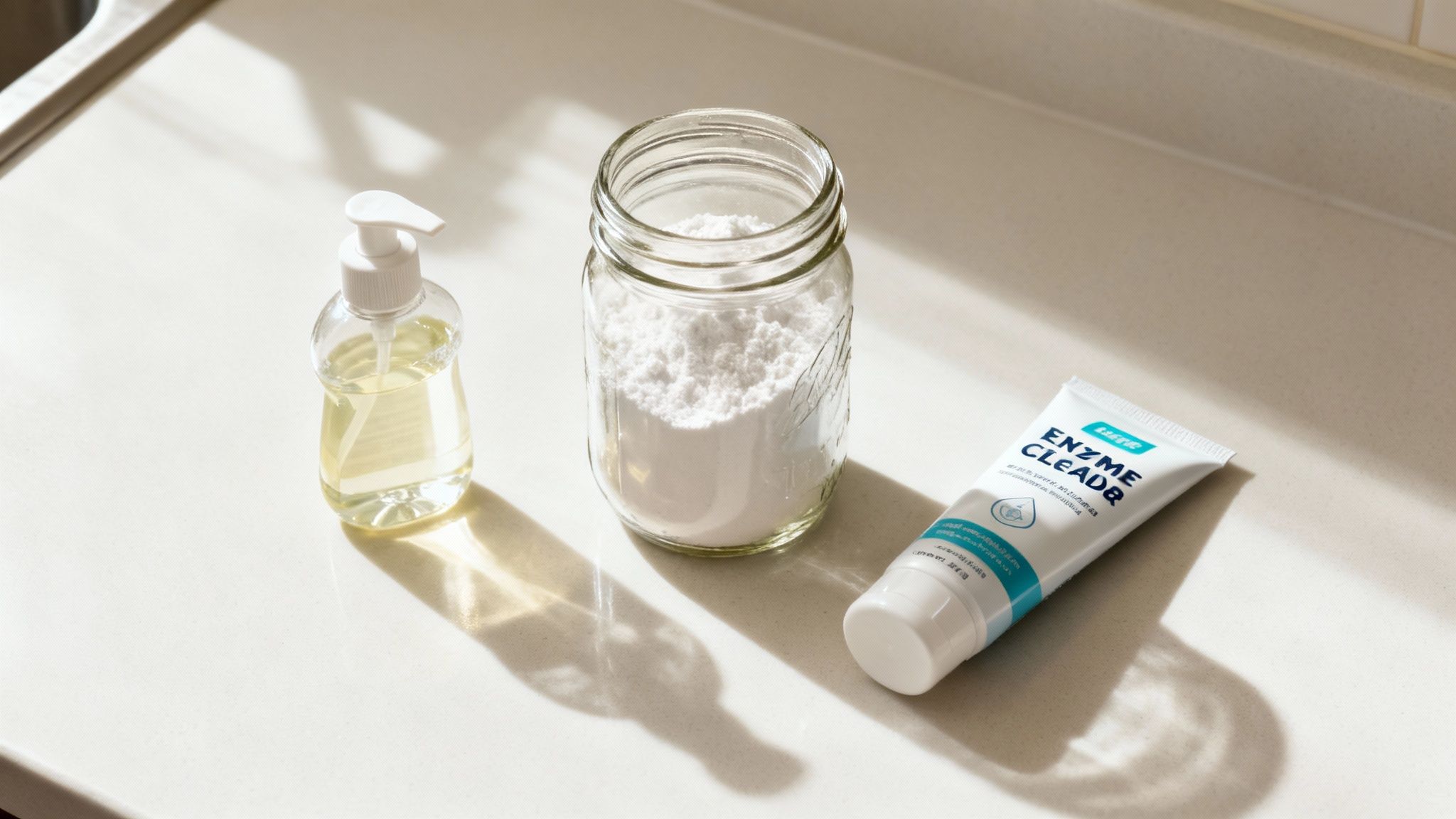
When you're staring down a stubborn oil stain, grabbing the right tool for the job is half the battle. The cleaning aisle can be a bit much, but honestly, one of the best solutions might already be sitting by your kitchen sink. What you choose really comes down to the fabric, how long the stain has been there, and what kind of oil you're up against.
A simple, powerful hero in the fight against grease is just plain old grease-cutting dish soap. It’s literally designed to break down fats, which makes it a perfect first line of defense for durable fabrics like cotton or polyester that can handle a bit of gentle scrubbing. The magic is in the surfactants, which emulsify the oil and let water wash it right away.
Kitchen Staples as Powerful Stain Fighters
Before you run out to buy a specialty product, take a look in your pantry. You’ve probably got several effective, gentle, and affordable options ready to tackle that grease.
- Baking Soda Paste: Just mix a little baking soda with a few drops of water to create a thick paste. Slather it right on the stain, let it dry completely, and then brush it off before tossing the item in the wash. The paste works by absorbing the excess oil while gently scrubbing the fabric fibers.
- White Chalk: This is an old tailor's trick for a reason—it works! Rub a piece of white chalk directly onto a fresh oil spot to absorb the grease. The fine particles of calcium carbonate pull the oil right out of the fabric. Just brush away the chalk dust before laundering.
These home remedies are fantastic for fresh spills on sturdy fabrics. They're proof that you don't always need a high-tech chemical solution to solve a common laundry headache.
Commercial Cleaners for Tougher Jobs
When a little dish soap or baking soda just won't cut it, it's time to bring in the big guns from the store. The global stain removers market was valued at a whopping USD 16.86 billion for a reason—people rely on these products for convenient and powerful cleaning.
As you're browsing, it's helpful to understand why citrus-based cleaning methods are effective; their natural degreasing properties are a huge plus.
A key takeaway here is to look for products specifically formulated for grease. Enzyme-based cleaners are your best bet, as they contain proteases and lipases that literally "digest" the fats and proteins that make up the stain.
For those nightmare stains that have already been through the dryer, you'll need a more aggressive approach. This is where you might reach for a solvent-based spot treatment, often labeled as a "dry cleaning solvent." These are designed to dissolve oil without water, but you have to be careful. Always test them on a hidden spot first to make sure they don't discolor or damage the fabric.
To get a better handle on the science, check out our guide on how stain removers work for every stain type. Matching the right remover to the right stain and fabric is the secret to saving your favorite clothes from an oily fate.
How to Properly Wash Oily Clothes
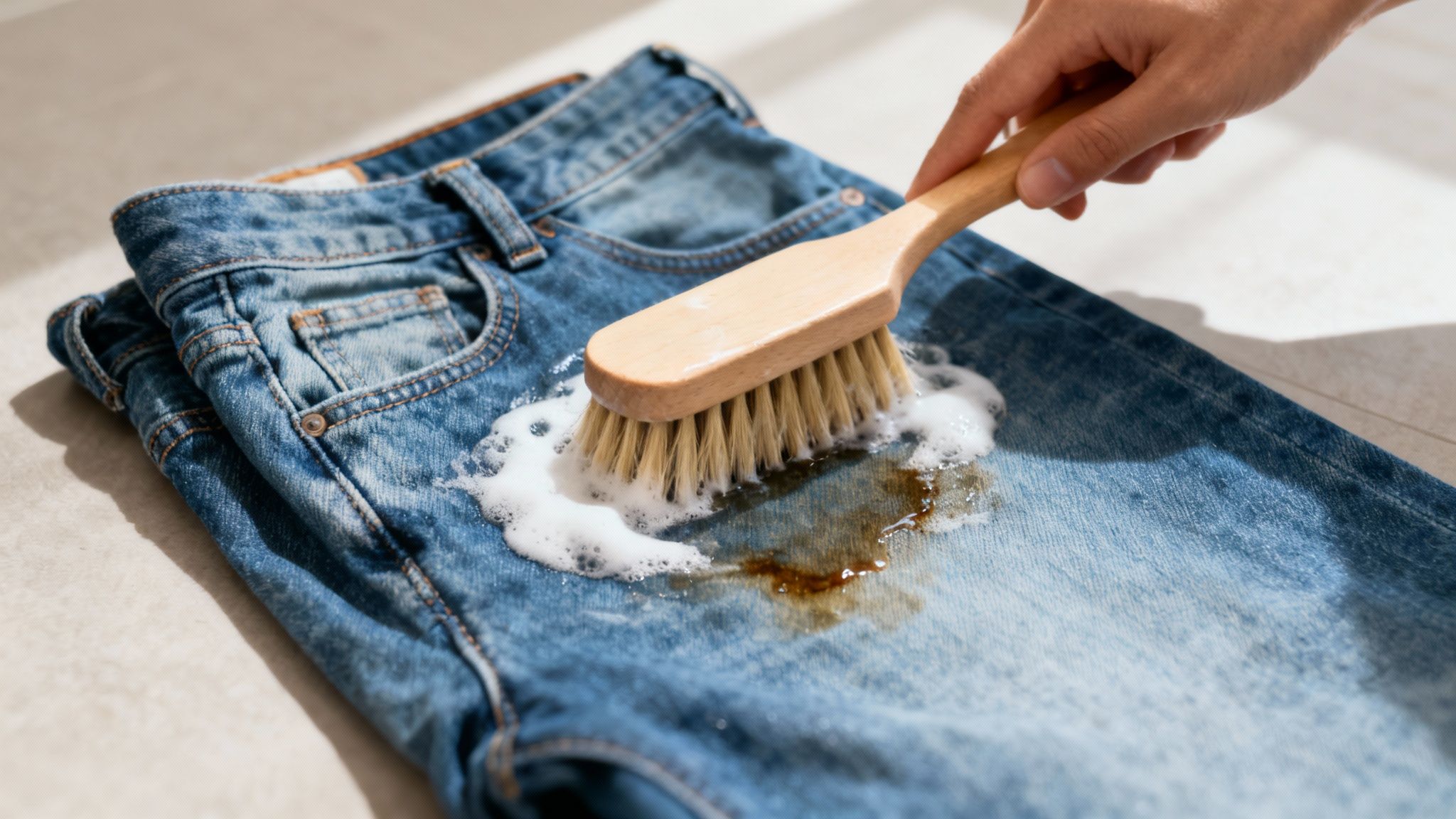
Getting that pre-treatment on the stain is half the battle, but the war isn't won yet. How you handle the wash cycle is just as critical. I've seen it a hundred times—someone does a great job pre-treating, only to toss the item into a regular load and hope for the best. The result? A faint, shadowy stain that just won't budge.
To completely knock out that grease, you need a specific game plan for the wash. This isn’t the time for a standard “set it and forget it” approach. A focused method ensures your pre-treater and detergent work together to break down and flush away every last particle of oil.
Work the Cleaner into the Fibers
That pre-treatment solution—whether it’s Dawn, a commercial stain remover, or your DIY baking soda paste—has to get deep into the fabric. Don't just dab it on the surface. You'll want to apply a generous amount right onto the oily spot until it's fully saturated.
Next, grab a soft-bristled brush. An old toothbrush is perfect for this. Gently work the cleaner into the fabric using small, circular motions. This little bit of elbow grease is key. It physically breaks up the oil molecules clinging to the fibers, making it way easier for the detergent to grab them and wash them away.
Once you’ve worked it in, let the garment sit for at least 15-30 minutes. This gives the cleaning agents time to really work their magic and dissolve the grease. For really nasty, set-in stains, I've even let things sit for a couple of hours.
Use the Hottest Water You Can
Heat is your best friend when fighting an oil stain. It helps melt the grease, making it much easier for your detergent to do its job. Before you even think about starting the machine, check the garment's care tag to see the maximum water temperature it can handle.
The rule of thumb is simple: wash the stained item in the hottest water the fabric can safely handle. For tough fabrics like cotton, linen, or most synthetics, that usually means a hot or warm cycle.
Just be careful with delicates. Wool, silk, or certain synthetics can shrink or get damaged by high heat. For those, you have to stick to the temperature on the care label, even if it’s cold. A solid pre-treatment will still give you a fighting chance.
The All-Important Post-Wash Inspection
This final step is absolutely non-negotiable. Seriously. Once the wash cycle finishes, pull the garment out and inspect the area while it's still damp. Hold it up to a bright light so you can get a really clear look.
If you see even a hint of the oil stain—a faint discoloration or a shadowy patch—do not put it in the dryer.
I can't stress this enough. The high heat from a machine dryer will essentially bake any leftover oil into the fabric, setting the stain for good. Once a stain is heat-set, getting it out is nearly impossible.
If you find the stain is still hanging on:
- Don't panic. This happens all the time with stubborn oil stains.
- Just repeat the process. Apply your stain remover again, scrub it in, let it sit, and run it through another wash cycle.
- Air dry only. Hang the garment to air dry completely until you are 100% certain the stain is gone. Only then is it safe to go into the dryer.
Dealing With Oil Stains on Delicate Fabrics
That aggressive stain-fighting technique that works wonders on a cotton t-shirt? It will absolutely ruin a delicate silk blouse or a favorite wool sweater. Getting oil stains out of these more sensitive materials isn’t impossible, but it definitely requires a much gentler touch.
The whole game is about avoiding the big three no-nos: harsh scrubbing, high heat, and strong chemicals. These will wreck the very fibers you're trying to save.
For fabrics like silk, rayon, and wool, your first move should always be a mild absorbent. Just like with sturdier fabrics, you can reach for cornstarch or talcum powder to start lifting that grease. Apply a generous layer over the stain, give it several hours to work its magic, and then gently brush it all off with a soft-bristled brush.
Gentle Cleansing Methods for Delicates
Once the powder has soaked up as much of the oil as it can, it’s time to wash the garment. Tossing it in the machine is almost always a bad idea—it’s just too rough for these fabrics.
Instead, you'll want to hand-wash it in cool or lukewarm water. Use just a tiny amount of a pH-neutral detergent made specifically for delicates, like a good wool wash. Submerge the garment, gently swish it around, and then just let it soak for about 30 minutes.
Crucial Tip: Whatever you do, never wring out delicate fabrics. Twisting and squeezing like that can stretch, warp, and even break the fine fibers. Instead, gently press the excess water out, then roll the item up in a clean, thick towel to absorb more moisture before laying it flat to air dry, far away from direct sunlight.
For a deeper dive into the specifics for tricky fabrics like silk, our guide on how to get oil stains out of silk breaks down the process with fabric-safe steps. It's no surprise that the demand for these kinds of gentle but effective solutions is growing. The global market for stain remover products was valued at around USD 23.4 billion and is only expected to grow, which really shows how much people are looking for specialized, fabric-safe formulas. You can find more insights on the stain remover products market and its trajectory.
What About Non-Washable Materials?
So, what happens when you’re dealing with materials that can't be washed at all, like suede or leather? This calls for a completely different strategy. Water and your usual detergents will just cause discoloration and serious damage.
For these non-washable items, here are your best bets:
- Cornstarch or Talcum Powder: Just like with silk, a fine powder is your best friend for a fresh oil spill. Cover the spot completely, let it sit overnight to absorb the oil, and then brush it away with a proper suede brush.
- Specialized Leather or Suede Cleaners: If the stain has already set, you're going to need a product formulated specifically for that material. These cleaners are designed to lift grease without stripping the material's natural oils or causing water damage.
Always, always test any cleaner on a hidden spot first, like inside a collar or cuff. When it comes to these valuable items, patience is your most important tool. A slow, careful, and methodical approach is the only way to get the oil out without creating an even bigger mess.
Removing Oil Stains From Carpet and Upholstery

We've all been there. That sinking feeling when a piece of pizza slides off your plate and lands face-down on the rug. Or when you notice a greasy handprint on the arm of your favorite chair.
Oil stains aren't just for clothes, and when they hit your furniture or carpet, the panic can feel even worse. You can't just toss a sofa cushion in the wash. But don't worry—the strategy is similar: act fast to absorb the oil, then work on lifting what's left behind.
First things first, get rid of any solid bits and then grab a clean, dry cloth to blot up as much of that excess oil as you can.
Next, you’ll want to cover the stain generously with an absorbent powder. Baking soda or cornstarch are your best friends here. Let it sit for at least an hour—honestly, several hours is even better. This gives the powder time to do its job and pull the grease out of the fibers. Once it's had time to work its magic, vacuum it all up.
Lifting Stains From Fabric Surfaces
After you've vacuumed away the powder, it's time to tackle what remains. My go-to solution is super simple: just mix a few drops of a clear, grease-fighting dish soap (think original Dawn) into a cup of warm water.
Dip a clean white cloth into your soapy water, and gently blot the stain. Always work from the outside edges of the stain inward. This little trick keeps you from accidentally making the spot bigger.
Important: Before you go all in, always test your cleaning solution on a hidden spot first. Under a cushion or on a patch of carpet in a closet is perfect. You need to make sure it won't bleach or damage the fabric.
Once you’re done with the soap solution, grab a new cloth, dampen it with plain water, and blot the area again to "rinse" it. To finish, press a dry towel firmly onto the spot to soak up as much of the leftover moisture as possible.
Tackling Tough Concrete and Garage Stains
Garage floors and driveways are a whole different beast. These surfaces are porous, so you’ll need something with more muscle to get the job done. Look for commercial concrete degreasers. Another effective method is creating a poultice by mixing an absorbent material, like kitty litter, with a strong solvent to draw out those deep-set oil stains.
This is a bigger issue than you might think; the market for concrete oil stain removers was valued at USD 150 million and is expected to keep growing. You can see more details in this report on the oil stain remover market.
And what about those really stubborn upholstery stains that just won't budge? Sometimes, it’s best to call in the professionals. Understanding how dry cleaners remove stains can give you a better idea of when it's time to let an expert take over to save your favorite furniture.
Got Lingering Oil Stain Questions? We've Got Answers.
Even when you feel like you've done everything right, some oil stains just dig in their heels and refuse to leave. It's frustrating, and these tricky situations usually bring up a lot of questions. Let's clear the air and troubleshoot some of the most common dilemmas people run into when fighting oil stains.
Can I Get an Old Oil Stain Out After It's Been Through the Dryer?
This is the big one, the final boss of oil stains. But even a heat-set stain isn't always a lost cause. The intense heat from a dryer basically "cooks" the oil deep into the fabric's fibers, which is why it becomes so incredibly stubborn. To stand a fighting chance, you have to bring out the heavy artillery.
Your best bet is to completely saturate the set-in stain with a solvent-based remover or a heavy-duty degreaser. Give it time to work its magic—let it sit for several hours, or even overnight. This long soak allows the solvent to slowly penetrate and break down that hardened oil.
Once it's had time to soak, work a generous amount of a grease-cutting dish soap into the area. I like to use a soft-bristled brush to gently scrub it in. Let that sit for another hour before washing it in the hottest water the fabric can safely handle.
Be prepared for a bit of a battle. You’ll likely need to repeat this entire process two or three times to see a real difference in a stain that's been baked in. Patience is your most important tool here, so don't get discouraged after the first try.
Does Salt Actually Work on a Fresh Oil Stain?
You’ve probably heard this trick, especially as a go-to move when you're out at a restaurant and a rogue French fry attacks. And while throwing some salt on a fresh spill is certainly better than doing nothing, it’s honestly not a very effective fix.
The problem is that the crystalline structure of salt isn't all that great at absorbing liquids. What you really want is a fine powder. Fine powders have a much larger surface area, which lets them act like millions of tiny sponges, drawing the oil up and out of the fabric far more efficiently.
- Best Options: Cornstarch, baking soda, or even baby powder.
- In a Pinch: Salt or an artificial sweetener packet from the table will do.
Think of it this way: salt might dab up a little oil from the surface, but it won't have the power to pull the grease out from deep within the fibers like a fine powder can.
Is Dish Soap Safe to Use on All Fabrics?
That trusty grease-cutting dish soap is an absolute powerhouse against oil, especially on durable fabrics like cotton, linen, and polyester. For most everyday clothes, it's a fantastic pre-treatment.
However, you need to be careful with your more delicate items. For fabrics like silk, wool, or cashmere, the strong surfactants in dish soap can be too harsh. They can strip the natural fibers, potentially causing damage or discoloration. For those special garments, always reach for a pH-neutral detergent specifically made for delicates. If you're ever in doubt, just do a quick spot test on a hidden area, like an inside seam, before tackling the main stain.
Battling a stain that just won't budge? Sometimes, the smartest move is to call in the professionals and save your favorite garment. Columbia Pike Laundry offers expert dry cleaning services designed to tackle even the toughest, most stubborn stains, giving your clothes a second life.
Popular Blog Articles

Meet the Author
Daniel Logan didn’t start CPL because he loved laundry. He started it because his family was drowning in time debt, and laundry was one of the biggest weights.
Mornings were chaos with two kids under 5. Evenings felt like catch-up. And weekends? Gone to sorting socks and folding piles.
He knew his story wasn’t unique. So he built a business that gave families like his just a little bit of breathing room one load at a time.
With no laundry experience but deep tech skills, Daniel rolled up his sleeves, doing every job himself while building systems that turned it into a modern laundry service that saves customers time, simplifies their lives, and delivers reliability they can count on.
That’s where CPL began. Not from a playbook, but from pain. From one dad trying to buy back time: for himself, and for every household like his.


